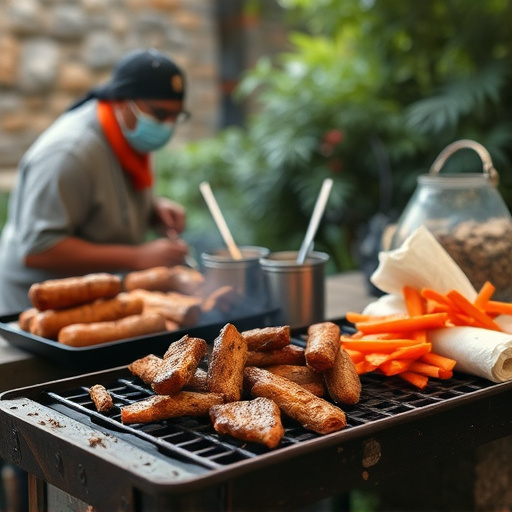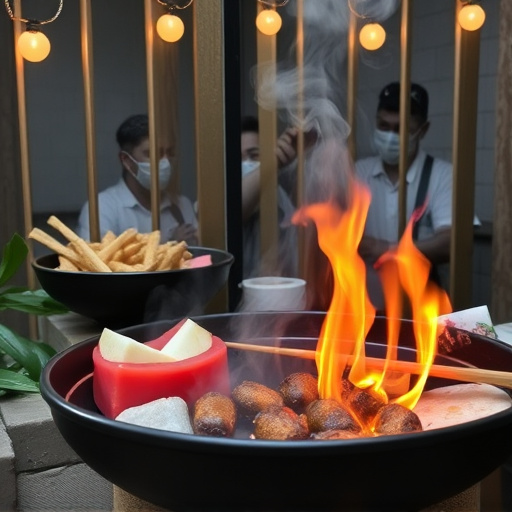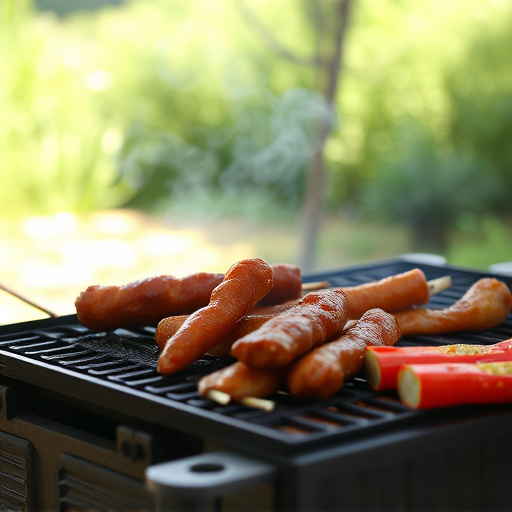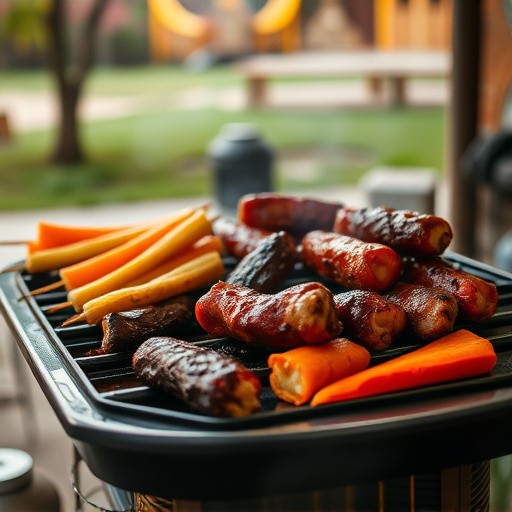Selecting the perfect cut of beef (marbled ribeye, brisket, chuck roast or thin cuts like steak tips) is key for a successful BBQ beef recipe. Seasoning and marinades enhance flavor and tenderize meat. Grill with indirect heat at 300-350°F (149-177°C), searing first at higher temps (450-500°F/232-260°C) to achieve the desired doneness, resting for juiciness.
Unleash the flavor of summer with a classic favorite—backyard barbecue beef! This ultimate guide will transform your grilling game, ensuring every bite is packed with deliciousness. From choosing the perfect cuts like ribeye or brisket to mastering grilling techniques and crafting mouthwatering marinades, we’ve got you covered. Learn to create a signature BBQ sauce and discover creative serving suggestions beyond buns. Plus, our storage tips ensure your leftovers stay fresh. Elevate your BBQ beef recipe with these expert insights and become the master of the grill!
- Choosing the Right Cuts of Beef for BBQ
- – Discuss different cuts suitable for barbecue, like ribeye, brisket, or chuck steak.
- Seasoning and Marinades: The Key to Flavor
- – Explore various seasoning blends and marinades to enhance beef flavor.
- Grilling Techniques for Perfect BBQ Beef
- – Provide tips on indirect heat grilling, searing, and achieving the desired doneness.
Choosing the Right Cuts of Beef for BBQ

When it comes to a classic BBQ beef recipe, selecting the right cuts is key to achieving tender, juicy results. Opt for cuts that are marbled with fat, as this adds flavor and keeps the meat moist during the slow cooking process. Ribeye, brisket, and chuck roast are popular choices for their rich taste and ability to withstand long hours of grilling. For a quick BBQ beef recipe, thin cuts like steak tips or flank steak can also work well, offering a more delicate flavor profile.
Consider the texture you desire – whether it’s melt-in-your-mouth tender or slightly chewier – as this will guide your cut selection. Each cut has its own unique characteristics and cooking times, so understanding these nuances ensures perfect BBQ beef every time. Whether you’re a seasoned griller or a beginner, choosing the right cuts will elevate your backyard BBQ experience.
– Discuss different cuts suitable for barbecue, like ribeye, brisket, or chuck steak.

When it comes to BBQ beef recipes, choosing the right cut is key for a delicious and tender result. For a classic backyard favorite, ribeye steak stands out with its rich marbling and juicy texture. It’s perfect for slow-cooking over low heat, allowing the flavors of your barbecue sauce to penetrate deep into the meat. Brisket is another popular choice among BBQ enthusiasts. This leaner cut requires more time and patience but results in a remarkably tender and flavorful dish when smoked slowly.
For those looking for a more budget-friendly option, chuck steak offers excellent value. While it may have more fat than other cuts, this adds to its flavor and juiciness when cooked correctly on the grill or smoker. Whether you prefer ribeye’s rich taste, brisket’s slow-cooked tenderness, or chuck steak’s affordability, each cut has its unique characteristics that contribute to a memorable BBQ beef experience.
Seasoning and Marinades: The Key to Flavor

Seasoning and marinades are the unsung heroes of any BBQ beef recipe, adding depth and richness that elevate simple meat into a mouthwatering dish. The key to unlocking flavorful bbq beef lies in balancing spices, acids, and oils to create a harmonious blend that sticks to the meat, tenderizing it as it cooks.
A good marinade or seasoning mix can transform a typical backyard barbecue experience into an unforgettable culinary journey. By allowing the meat to soak up the flavors for an hour or more, you infuse each bite with aromatic spices like garlic, paprika, and black peppercorns, balanced by tangy notes from vinegar or citrus juices. This process not only enhances taste but also helps break down tough muscle fibers, making the beef incredibly tender and juicy when grilled to perfection.
– Explore various seasoning blends and marinades to enhance beef flavor.

When crafting a mouthwatering BBQ beef dish, one of the secrets lies in exploring diverse seasoning blends and marinades. This simple yet effective step can drastically enhance the overall flavor profile of your barbecue beef recipe. Experiment with different combinations of spices such as garlic powder, paprika, salt, pepper, and onion powder to create a custom rub that sticks to your meat like magic. For a more immersive experience, marinate your beef in a mixture of olive oil, vinegar, herbs (like thyme or rosemary), and your choice of BBQ sauce for several hours before grilling. This process tenderizes the meat and infuses it with rich, smoky flavors.
Don’t be afraid to get creative; different seasoning blends and marinades can transform an ordinary BBQ beef recipe into an extraordinary culinary delight. Whether you prefer a spicy kick or a sweet and tangy twist, there’s a perfect blend out there for every taste. So, grab your ingredients, put on your apron, and start experimenting—your future grill sessions (and dinner tables) will thank you!
Grilling Techniques for Perfect BBQ Beef

Achieving perfection in grilling BBQ beef starts with selecting the right cut of meat. Opt for a marbled, well-marbled ribeye or strip steak—the higher fat content ensures juicy results. Before cooking, allow the meat to come to room temperature; this promotes even cooking. Season generously with salt and pepper on both sides. Preheat your grill to high heat, ensuring it’s nice and hot before placing the steaks. For authentic BBQ flavors, consider adding a dry rub of paprika, garlic powder, onion powder, salt, and black pepper.
Searing at high temperatures first locks in juices and creates that delicious crusty exterior. Grill for 4-5 minutes on each side until nicely browned. Then, lower the heat to medium-low direct heat for slow cooking, allowing the beef to reach its desired doneness (aim for 120°F–130°F for rare to medium-rare). Resting the meat for 5-10 minutes before slicing ensures those juicy flavors distribute evenly throughout.
– Provide tips on indirect heat grilling, searing, and achieving the desired doneness.

When grilling BBQ beef, mastering the art of indirect heat is key to achieving the perfect doneness while locking in that juicy flavor. Start by preheating your grill to a low temperature, around 300-350°F (149-177°C). This gentle heat allows for slow cooking, ensuring your beef stays tender and succulent. Place your meat on the grill over the indirect heat source, like a cast-iron skillet or chunk of hardwood, which will help create a stable, even temperature environment.
For searing, bring the grill temperature up to medium-high around 450-500°F (232-260°C) and sear your beef on all sides for a few minutes to develop that delectable crust. Once seared, reduce the heat again to maintain an indirect cooking environment. Use a meat thermometer to track the internal temperature; for a medium-rare BBQ beef recipe, aim for around 135°F (57°C). Remember, it’s better to undercook slightly and let the meat rest before serving than to overcook. This resting period allows those delicious juices to redistribute throughout the beef, ensuring every bite is mouthwateringly tender.
